- Self-healing phenomena using PVA coated granules for sustainable construction
Jun Hyeong Kima, Yong-Soo Leeb, Abdul Qudoosa, Hong Gi Kima, Tae Ho Ahnc and Jae-Suk Ryoua,*
aDepartment of Civil & Environmental Engineering of Civil Engineering, Hanyang University; 222 Wangsimni-ro, Seongdong-gu, Seoul 04763, Korea
bKorea Concrete Testing Laboratory; 35 Ansantekom-gil, Sangnok-gu, Ansan 15523, Korea
cInternational Sustainable Engineering Materials (ISEM) Center, Ceramic Materials Institute & Division of Advanced Materials Science Engineering, Hanyang University; 222 Wangsimni-ro, Seongdong-gu, Seoul 04763, Korea
Concrete structures are susceptible to cracking which exacerbate the durability of these structures. For this purpose, self-healing phenomena has been introduced in the past few decades. In order to apply the granulated healing material (Granule) with PVA film coating in the concrete, cracks, which were generated by drying shrinkage, were introduced to plate-shaped concrete specimens incorporating Granule with PVA film coating. Subsequently, healing efficiency was verified by test about crack, which was subjected to the water supply. As a result, it is verified that the method by using water-soluble PVA film coating for maintaining self-healing efficiency of the granulated healing material will be the original approach for sustainable concrete with self-healing capability compared with the previous method.
Keywords: Granulated healing material, Drying shrinkage, Water supply, Water-soluble PVA film
Concrete cracking, which is occurred by various factors, can subject to degradation of performance such as appearance, durability, permeability and so on. Also, Crack that occurred to RC structures affects psychological worry by appearance damage of structures as well as structural damages, which include reduction of structural strength/stiffness, carbonation, the cause of rebar’s corrosion and so on. In particular, the damage by permeability can affect to contamination/corrosion of interior material, additionally. Therefore, concrete contractors should be noted to cracking because various damages are caused. Also, concrete structures crack cannot be avoided regardless of size. Although prevention of concrete crack is developed from the past, adequate prevention has not been achieved because of complicated crack mechanism and various characteristics of composition materials (e.g. cement, aggregate etc.). However, because interest on crack is growing rapidly according to the change of structures design method, construction technology, and site condition, the corresponding measures are required [1].
In the previous study, it was researched that granulation/coating methods are applied to CSA expansive agent and cementitious material. The self-healing efficiency of materials can be maintained via PVA film thickness until cracks occur, and healing products will be formed because materials react with moisture via the crack faces after PVA film was dissolved by moisture [2, 3]. The crack that generated in concrete is caused by drying shrinkage typically. Concrete holds with characteristics of expansion and shrinkage by absorption of heat and drying, respectively. In particular, drying shrinkage occurs by evaporation of non-saturated steam and moisture [4]. Therefore, cracks, which were generated by drying shrinkage, were introduced to plate-shaped concrete specimens incorporating cementitious material with PVA film coating. Subsequently, healing efficiency was verified by test about crack, which was subjected to the water supply. Also, it was verified that cementitious material with PVA film coating did not affect workability and strength of concrete.
Crack that is occurred after hardening is divided into the short-term crack, which is occurred within 28 days, and long-term crack, which is occurred progressively after 28 days curing or during 5~10 years. Crack after hardening is occurred into numerous patterns due to several factors. Therefore, crack that occurs due to several factors may affect structures variously.
Short term crack that is caused by shrinkage occurs in the initial curing process. The causes can be classified into resistance against volume expansion that occurs by structural restriction and tensile stress that generates by plastic shrinkage. Typical crack after hardening is classified into drying shrinkage crack, crack by physical/chemical reaction, and crack by structural factors. Concrete holds with characteristics of expansion and shrinkage by absorption of heat and drying, respectively. In particular, drying shrinkage occurs by evaporation of non-saturated steam and moisture. Therefore, Crack can occur if concrete members are restricted on elongation/contraction. However, if concrete is able to shrink freely or drying shrinkage occurs without restraint, the crack does not occur. Drying shrinkage is contraction phenomenon of concrete due to evaporation of moisture, and shrinkage occurs by loss of moisture that is included in the gel. It depends on cross-sectional dimensions and humidity in the air. In particular, the amount of shrinkage of normal concrete depends on initial water content, temperature/humidity condition around the site, aggregate characteristics [5].
Cracking mechanism by drying shrinkage indicates in Fig. 1. As shown in Fig. 1(b), if shrinkage stress that is generated by drying occurs in a free end, the crack does not occur because member length reduces without restriction. On the other hand, shrinkage stress occurs in the fixed end, a crack occurs when shrinkage stress is larger than tensile stress of concrete [6].
Therefore, the Plate-shaped concrete specimens of 700 × 500 × 60 mm were made to introduce drying shrinkage crack that is typical among crack type. Two-Stage rebar with 50 mm spacing was installed for generating tensile stress which can be induced drying shrinkage crack. Subsequently, the condition of 30 ℃ temperature and 40% humidity was continued for 30days. As a result, cracks (range: 0.05-0.35 mm) were created in the Plate-shaped concrete specimens by drying shrinkage. Fig. 2 indicates cracks that formed by drying shrinkage on the plate-shaped concrete specimen.
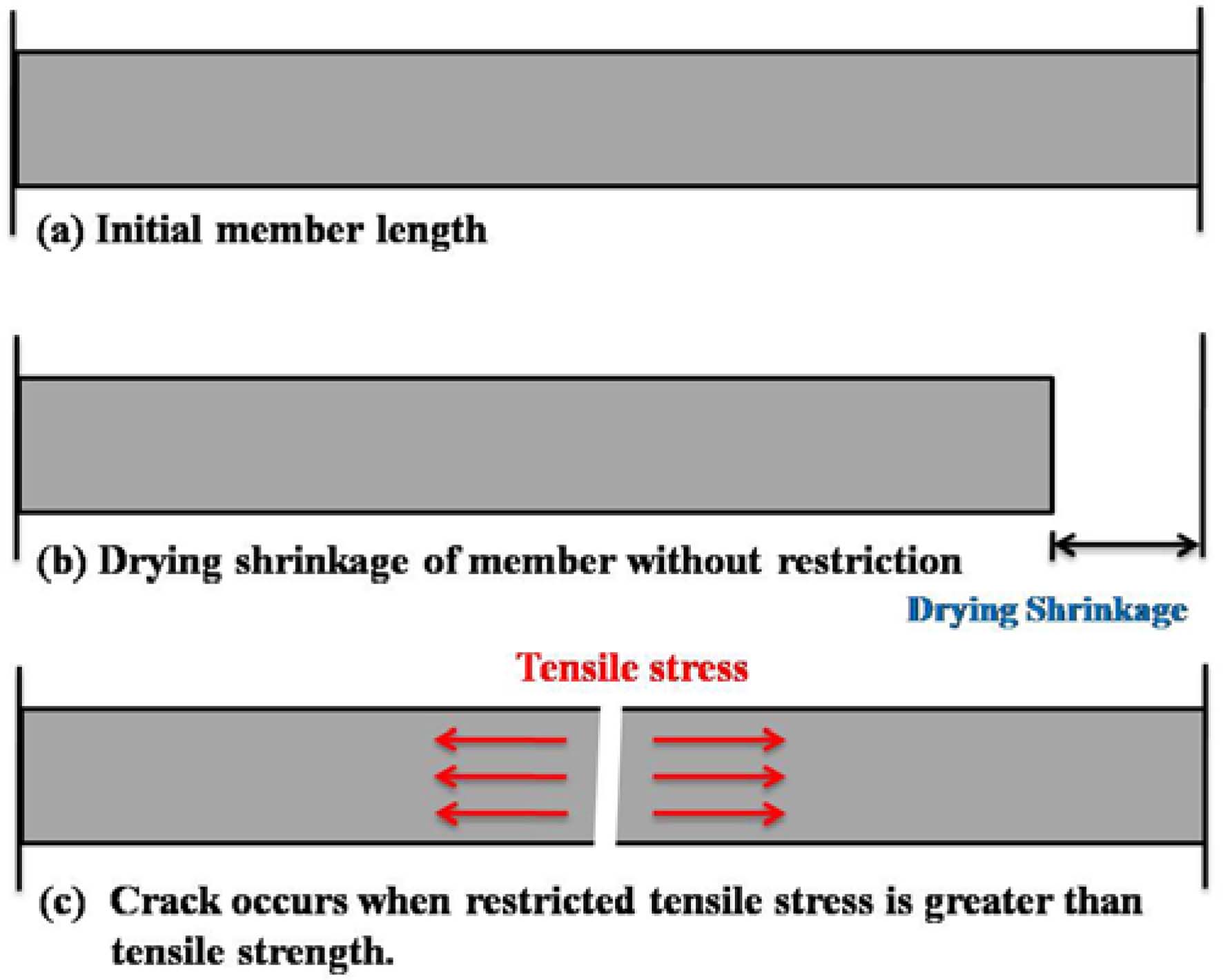
|
Fig. 1 Cracking mechanism due to drying shrinkage. |
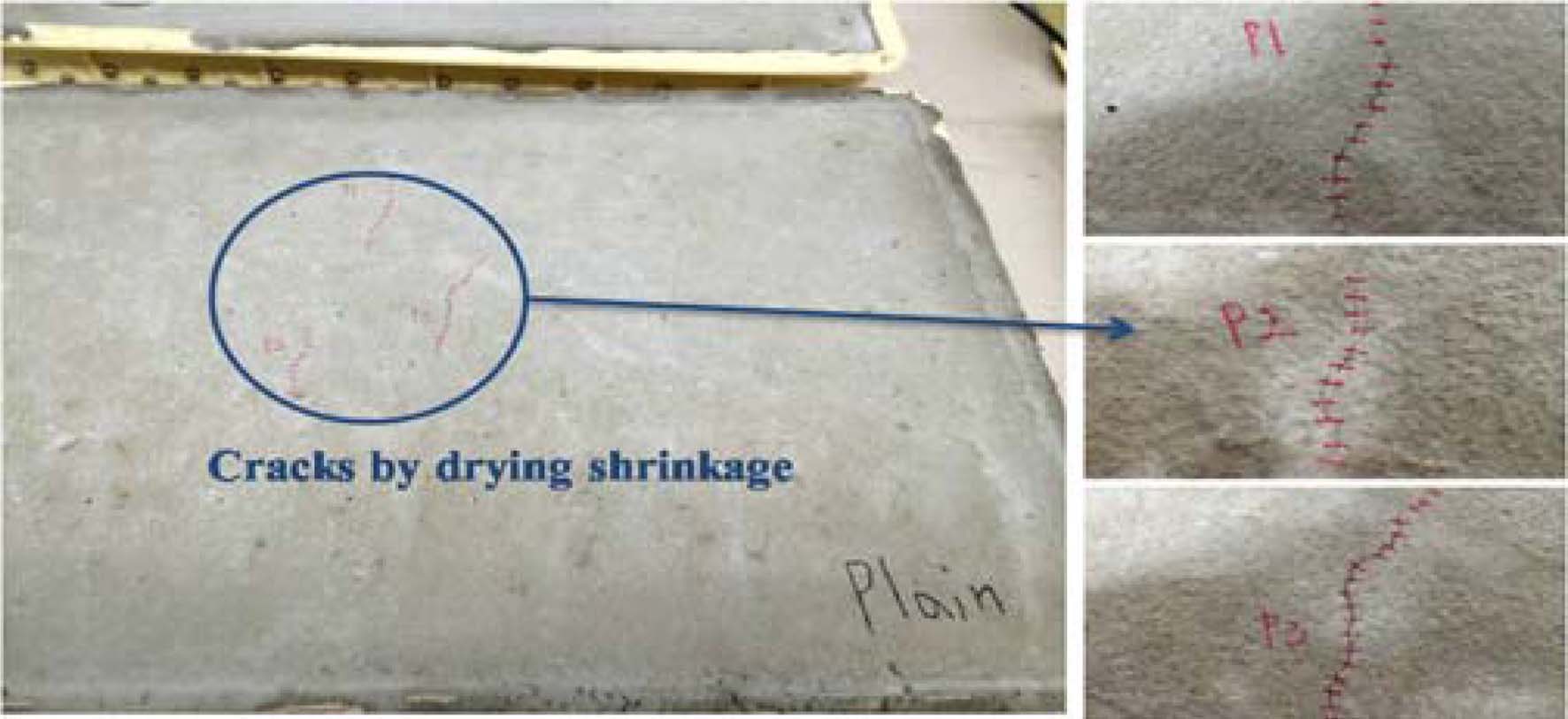
|
Fig. 2 Cracks that formed due to drying shrinkage. |
The pilot test was conducted according to according to the mix design method that specified in KCI. And then the concrete mixtures were determined to have the following properties: W/C = 50.0%; S/a = 49.5%; target slump = 150 mm; and target strength at 28days = 21 MPa. Concrete mixture level included Plain, Granule-EA, and Granule-Cm as shown mentioned in chapter 5. Where EA is the granulated CSA-based healing material with PVA film coating, Cm is the granulated cementitious material (Cement+CSA-based expansive agent +sodium carbonate). In particular, Granule-Cm used #2 (CSA-based expansive agent to cement ratio = 2:8) that indicated the superior healing efficiency. Cracks (range: 0.05-0.35 mm) were created in the Plate-shaped concrete specimens by drying shrinkage, and then the self-healing closing ratio and crack images were obtained via microscopy investigation. Also, internal self-healing efficiency was evaluated through the change in crack depth, which was measured by ultrasonic velocity. In addition, water passing test was conducted. Table 1 indicates detail of the experimental procedure.
In this study, in order to introduce drying shrinkage crack, plate-shaped concrete specimens were cured under condition of 30 ℃ temperature and 40% humidity for 30 days. Subsequently, cracks (range: 0.05-0.35 mm) were created in the Plate-shaped concrete specimens by drying shrinkage. As shown in Fig. 3, moisture was flowed in crack faces by using a water supply system in order to simulate the condition of water leakage. Afterward, the crack widths and images were obtained via microscopy investigation depending on the elapsed time with respect to each mixture.
Changes in the crack width and image by microscopy investigation are qualitative evaluation [7]. Therefore, many researchers were attempted various quantitative evaluations for self-healing efficiency. The modified self-healing closing ratio (β(t)) which, was mentioned in literature, was introduced in this study [8]
. Self-healing closing ratio β(t) at a specific time can be calculated by using the following equation 1.

Where, Ai is an initial area of crack before self-healing, A(t) is an area of crack-closing at a specific time. β = 0 means that no crack-closing occurs while β = 1 means that complete crack-closing has been achieved. Therefore, self-healing efficiency verified by using equation 1 on the change in crack width which was investigated by a mobile microscope.
Ultrasonic pulse velocity method is very useful with respect to the investigation of crack depth. A basis for measurement of crack depth is to install transducers on the same plane with crack. Various methods for measurement of crack depth have been suggested depending on detecting the type of wave and items. Among them, Tc-T0 method is the most typical. In Tc-T0 method, transducers (transmitter and receiver) are installed at intervals L/2 from the center of the crack opening, and then propagation time around crack obtains by using pulse velocity instrument [9]. Also, propagation time along the surface of the same type concrete without any crack obtains. The crack depth can be calculated by using the following equation 2.

Although recovery of crack on the surface of the specimen can be monitored via microscope, internal crack of the specimen is unable to monitor via microscope. Therefore, propagation times were measured depending on elapsed time by using pulse velocity instrument with respect to each crack, which formed on plate-shaped concrete specimens. Afterward, crack depths at a specific time were obtained by using equation 2. Self-healing efficiency of internal crack was evaluated based on internal self-healing closing ratio (β(t)), which can be calculated by using the following equation 3.

Where, Di is a crack depth before self-healing, D(t) is a crack depth at the specific time. β = 0 means that no internal crack-closing occurs while β = 1 means that complete internal crack-closing has been achieved. Fig. 4 indicates a view of the measurement of propagation time by pulse velocity instrument.
In this study, with respect to each plate-shaped concrete specimen, coring operations (the part with and without any crack) was conducted. As a result, specimens of 100 × 50 mm for water passing test were obtained. Also, side of specimens was sealed by using epoxy to prevent penetration of water through the side. Afterward, a water passing test, which can be evaluated prevention of aggressive agents such as the migration of water due to crack faces, was conducted on prepared specimens. Healing efficacy was evaluated via the water permeability coefficient that was calculated by using the following equation [10]. Fig. 5 indicates an instrument and view of water passing test.

Where k is water permeability coefficient (cm/s), a is the cross-sectional area of the pipette (cm2), L is the specimen thickness (cm), A is the cross-sectional area of the specimen (cm2), t is the time (seconds), h1, h2 is the initial and final water heads (cm).
Also, self-healing efficiency was evaluated by using the water permeability coefficient at a specific time. Self-healing closing ratio (β(t)) by water permeability coefficient can be calculated by using following equation 5.

Where ki is a water permeability coefficient before self-healing, k(t) is a water permeability coefficient at a specific time. β = 0 means that no crack-closing occurs while β = 1 means that complete crack-closing has been achieved.
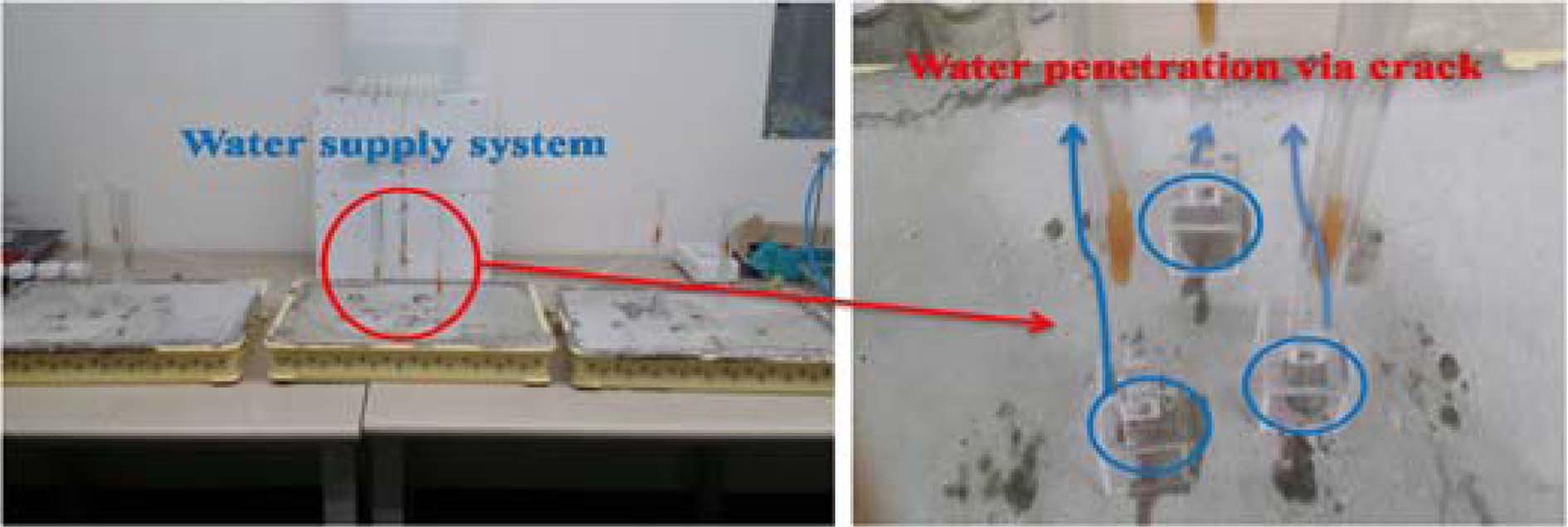
|
Fig. 3 Water penetration test setup. |

|
Fig. 4 Ultrasonic pulse velocity measurement. |
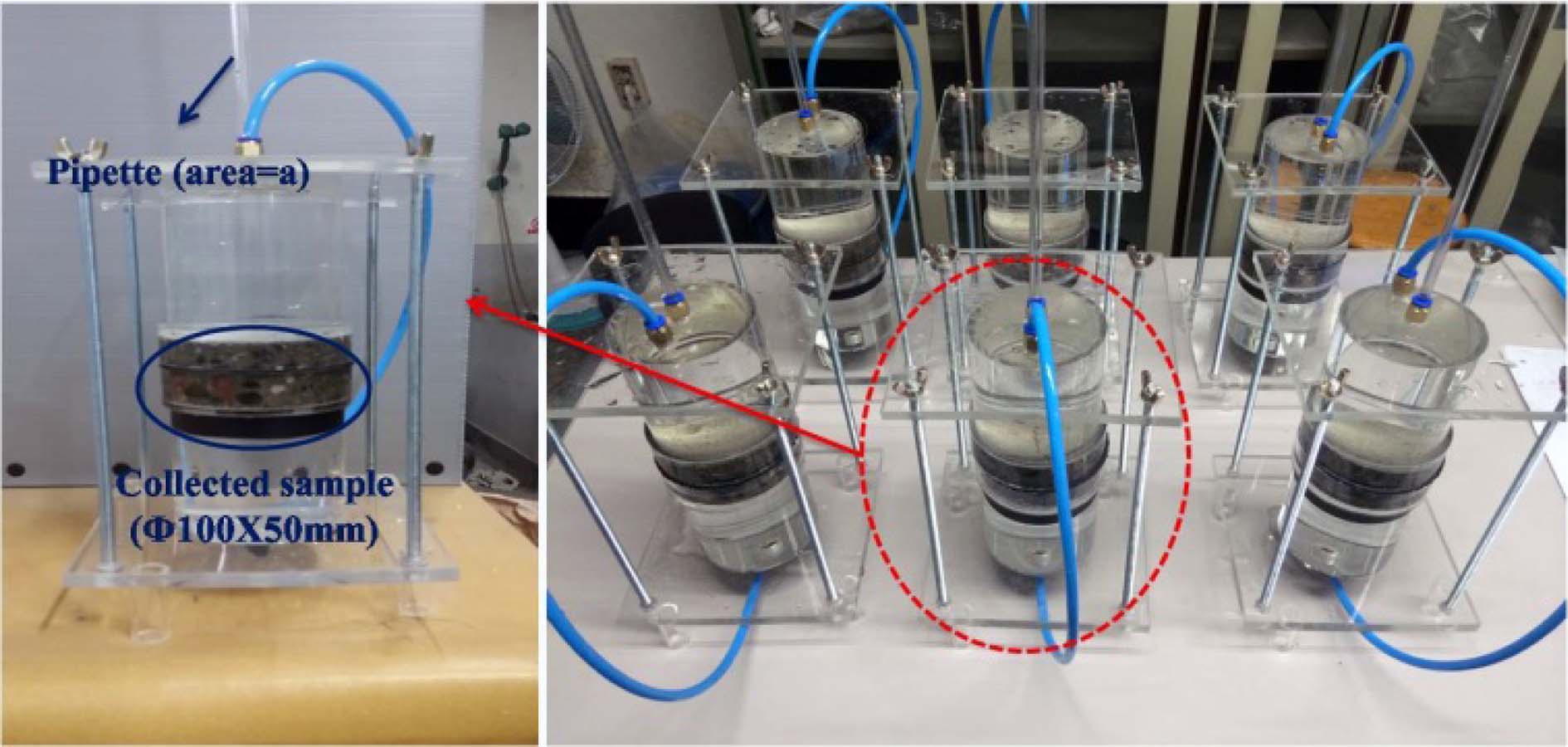
|
Fig. 5 Water passing test. |
|
Table 1 Concrete mix details. |

* Granule-EA: the granulated CSA-based expansive agent with PVA film coating. |
The Plate-shaped concrete specimens of 700 × 500 × 60 mm were made to introduce drying shrinkage crack that is typical among crack type. Subsequently, the condition of 30 ℃ temperature and 40% humidity was continued for 30 days. The prepared specimens are concrete incorporating Plain, Granule-EA, and Granule-Cm as shown mentioned above. Microscopy investigation was conducted on a representative three-site with respect to each mixture. The crack width that formed on each mixture indicates in Table 2.
After drying shrinkage crack occurred, moisture was flowed in crack faces by using water supply system. Afterward, changes in crack width observed by a mobile microscope. Self-healing closing ratio (β(t) at a specific time can be calculated by using the following equation 1. Table 2 indicates self-healing closing ratio (β(t) of each specimen, which holds 0.05-0.35 mm crack width, at a specific time. Where β = 0 means that no crack-closing occurs while β = 1 means that complete crack-closing has been achieved. In Fig. 6, self-healing did not achieve because self-healing closing ratio of Plain is below 0.40 at 40-days. In particular, although a little self-healing efficiency shows up to 30-days, self-healing closing ratio hardly changed since then. It verified that complete crack-closing did not achieve by only CaCO3, which would be formed by their action of the leached Ca(OH)2 out of the cracks and the CO2 in the air. Self-healing closing ratio of Granule-EA significantly increased since 10-days, and that of Granule-EA-1 was achieved within 20-days, and that of Granule-EA-2,3 were achieved within 27-days. Finally, self-healing closing ratio of Granule-Cm, which indicates the granulated cementitious material with PVA film coating, shows constant slope since 5-days. Granule-EA indicates complete crack-closing because of that of Granule-EA-1, 2, 3 show 1.0 at 28, 30, 31-days, respectively. Therefore, it was verified that all mixtures, except for the Plain, was achieved complete crack-closing within 31-days.
Also, as mentioned from the results in previous research, time of crack-closing of Granule-EA (CSA-based healing material) is faster than that of Granule-Cm (Cement+CSA-based expansive agent +sodium carbonate) [2]. This indicates that the formation rate of healing products, which were formed on crack faces by hydration of healing material (CSA-based expansive agent and cementitious material) is different. Therefore, it was verified that the healing material of the inside might have reacted with water because the water-soluble PVA film was dissolved by the migrated moisture via the crack faces. As a result, crack-closing was achieved.
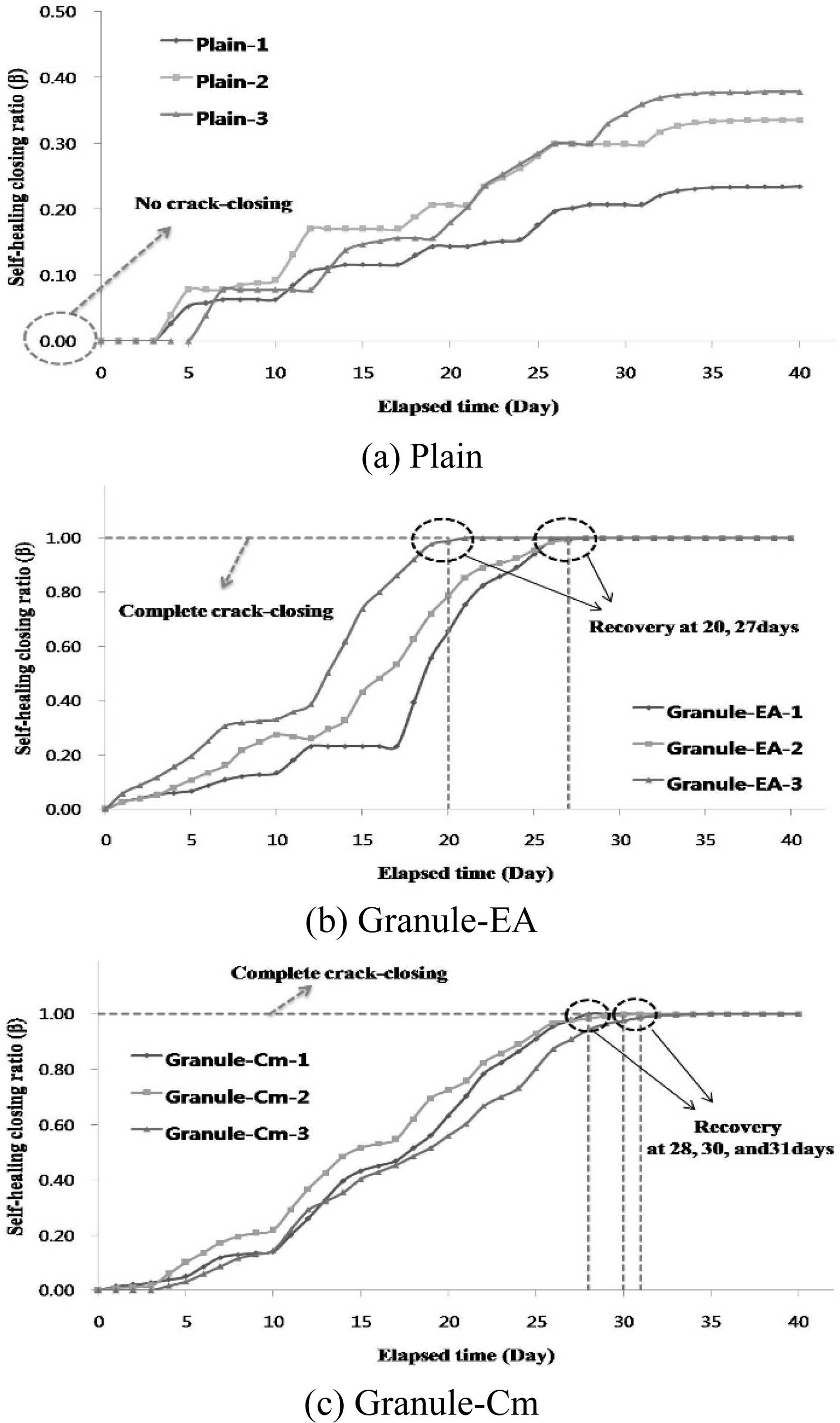
|
Fig. 6 Self-healing closing ratio of each mixture depending on elapsed time: (a) Plain (b) Granule-EA (c) Granule-Cm. |
Although recovery of crack on the surface of the specimen can be monitored via microscope, internal crack of the specimen is unable to monitor via microscope [11]. Therefore, propagation times were measured depending on elapsed time by using pulse velocity instrument with respect to each crack, which formed on plate-shaped concrete specimens. Afterward, internal crack-closing was evaluated by crack depths at a specific time, which were obtained by using equation 2. Table 3 indicates changes in crack depth of each crack depending on elapsed time. Where, Plain-1,2,3 are crack range of 0.1-0.35 mm, 0.05-0.25 mm, 0.05-0.3 mm, respectively. and Granule-EA-1,2,3 are crack range of 0.1-0.3 mm, 0.05-0.25 mm, 0.05-0.15 mm, respectively. Finally, Granule-Cm-1,2,3 are crack range of 0.05-0.15 mm, 0.05-0.2 mm, 0.05-0.3 mm, respectively.
As shown in Table 3, depths of drying shrinkage crack that formed on each plate-shaped concrete specimen are as follow: Plain-1,2,3 indicate 33.90 mm, 23.81 mm, 29.61 mm, and Granule-EA-1,2,3 indicate 27.55 mm, 26.84 mm, 18.89 mm Finally, Granule-Cm-1,2,3 indicates 20.39 mm, 23.82 mm, 32.08 mm, respectively. In particular, there are sites that hold a similar range in crack width (e.g. Plain-3, Granule-EA-1, and Granule-Cm-3 etc.).
Also, self-healing efficiency on internal crack was evaluated by self-healing closing ratio, which was calculated by using equation 3. Fig. 7 indicates an internal self-healing closing ratio of each mixture depending on elapsed time. In Fig. 7(a), self-healing did not achieve because internal self-healing closing ratio of Plain is below 0.3 after 40-days. These values are the lower compared to that compared to results of microscopy investigation. it can be supposed that the crystals such as calcium carbonate did not form in the internal crack. On the other hand, the calcium carbonate was formed on surface crack according to microscopy investigation. Also, internal self-healing closing ratio was hardly changed since 30 days. As shown in Fig. 7(b), internal self-healing closing ratio of Granule-EA significantly increased since 10-days as shown in microscopy investigation, and that of Granule-EA-1 was over 0.95 within 20-days, and that of Granule-EA-2,3 were 0.95 within 27-days. Therefore, internal crack-closing of Granule-EA was achieved within 27-days. As mentioned above, complete internal crack-closing was achieved when internal self-healing closing ratio is over 0.95. Finally, in Fig. 7(c), internal self-healing closing ratio of Granule-Cm shows constant slope since 5-days, and that of Granule-EA-1, 2, 3 show over 0.95 at 26, 28, 28-days, respectively. Therefore, it was verified that all mixtures, except for the Plain, was achieved complete internal crack-closing within 28-days. In particular, these results are faster than the time of crack-closing, which obtained in microscopy investigation. Therefore, it can be supposed that the time of internal crack-closing is faster than that of surface crack-closing.
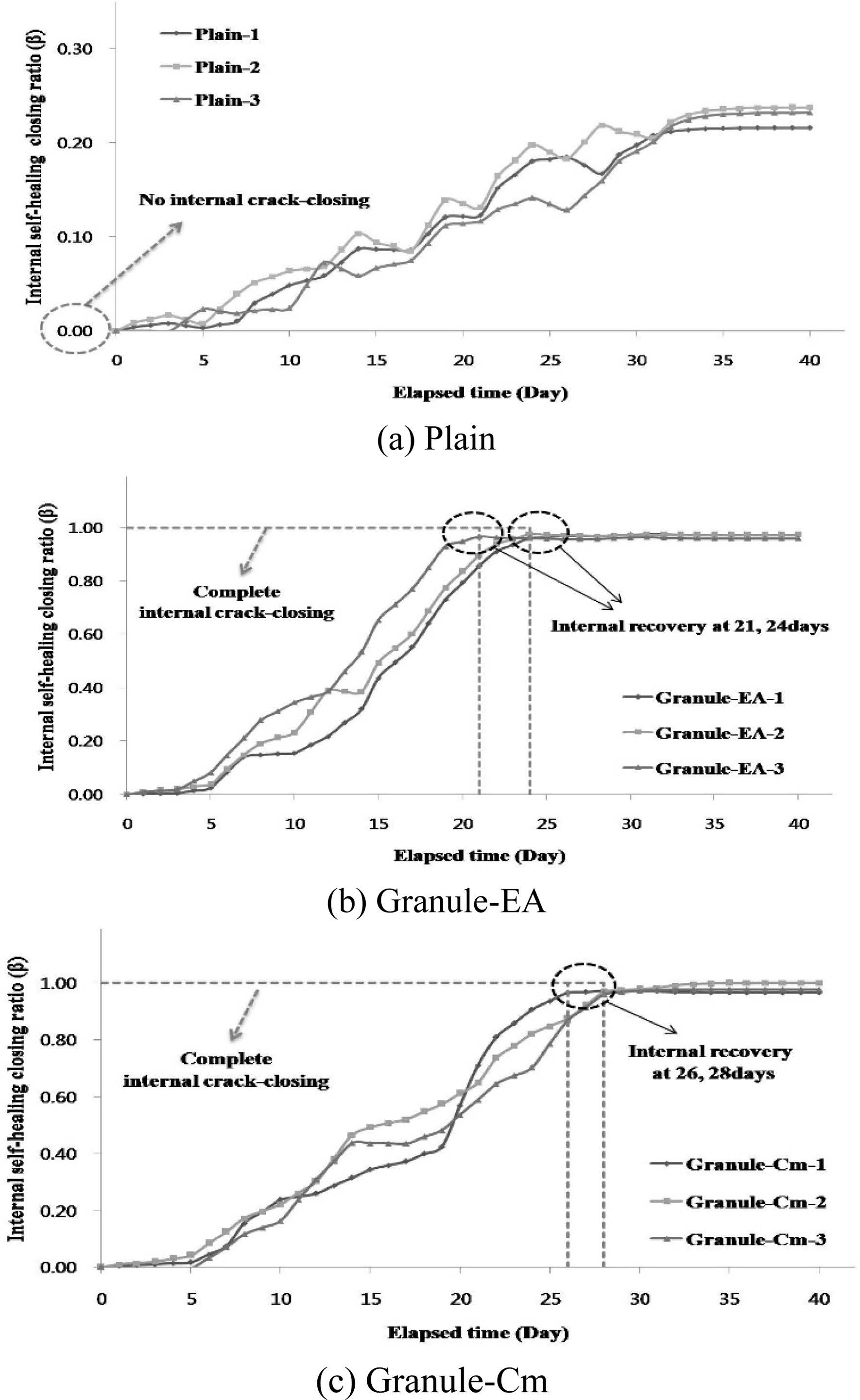
|
Fig. 7 Internal self-healing closing ratio of each mixture depending on elapsed time: (a) Plain (b) Granule-EA (c) Granule-Cm. |
|
Table 3 Changes in the crack depth of each mixture depending on the elapsed time. |

It was mentioned in the literature that concrete improvement by self-healing plays an important role in the prevention of water migration rather than in the recovery of the mechanical properties [12]. Coring operations (the site with and without any crack) was conducted with respect to each plate-shaped concrete specimen, and then specimens of 100 × 50 mm for water passing test were obtained. Subsequently, the water passing test of prepared specimens was conducted. Table 4 indicates crack width of each mixture for water passing test. Plain-0, Granule-EA-0, and Granule-Cm-0 indicate specimen without any crack for water passing test.
Subsequently, self-healing closing ratio was evaluated by using the obtained water permeability coefficient at specific ages. Fig. 8 indicates the self-healing closing ratio of each mixture depending on elapsed time. In Fig. 8, although the self-healing closing ratio of Plain shown a significant deviation up to 30-days, they indicate a stable value after then. Self-healing closing ratio of this time is below 0.3, and it indicates that crack closing for improvement of permeability resistance was hardly achieved. Self-healing closing ratio of Granule-EA noticeably increased since 10-days, and that of Granule was over 0.95, which means complete crack-closing, after 20-days. Finally, Self-healing closing ratio of Granule-Cm shows constant slope since 5-days, and that of Granule-EA was over 0.95 after 26-days. Where it was evaluated that complete crack-closing was achieved when self-healing closing ratio is over 0.95 because their water permeability coefficient did not match to that of specimens without any crack. Therefore, the crack closing, which prevents water migration through the self-healing of the granulated healing material with PVA film coating, was verified by self-healing closing ratio.
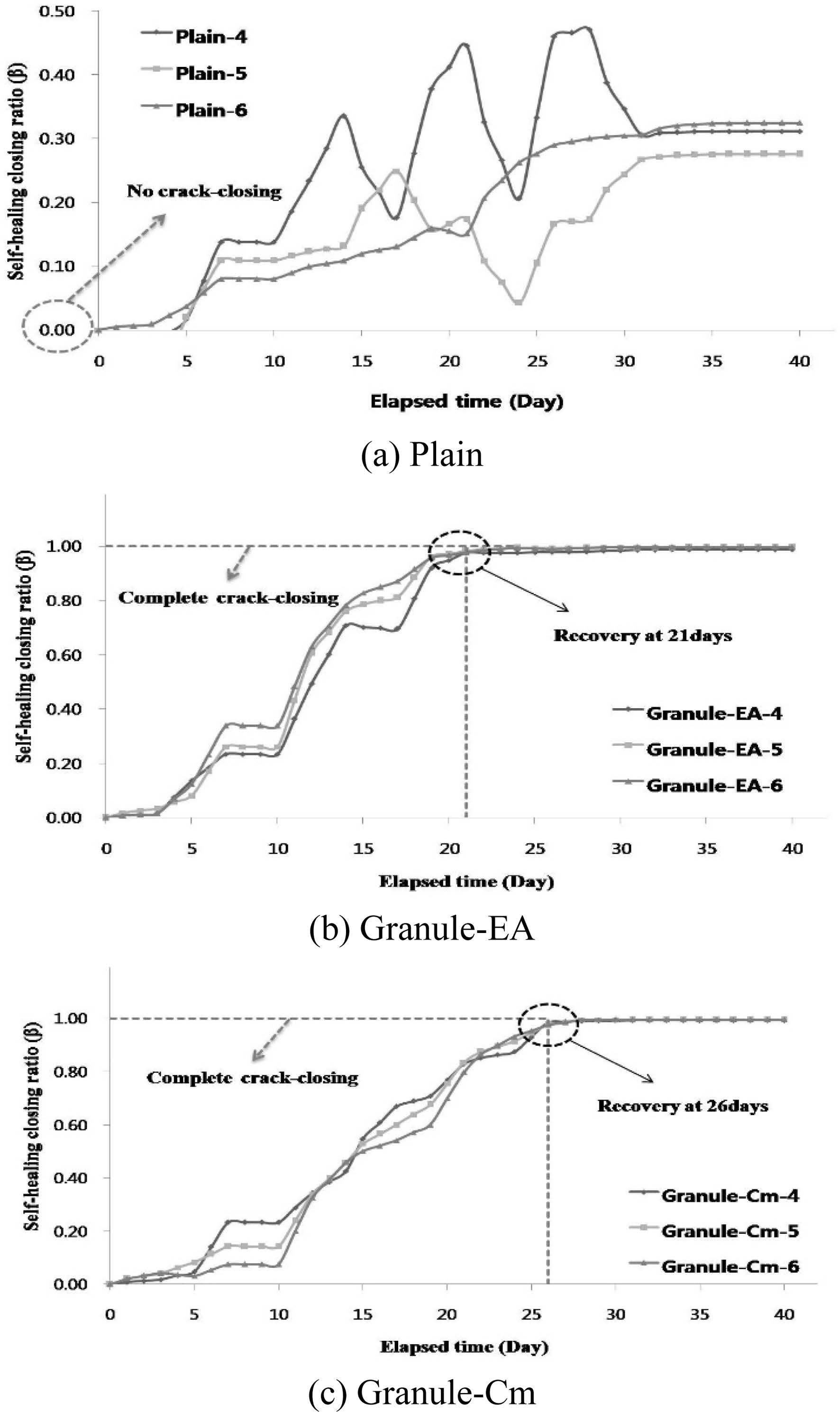
|
Fig. 8 Self-healing closing ratio depending on elapsed time by water permeability coefficient: (a) Plain (b) Granule-EA (c) Granule-Cm. |
In order to apply the granulated healing material (Granule) with PVA film coating in the concrete, cracks, which were generated by drying shrinkage, were introduced to plate-shaped concrete specimens incorporating Granule with PVA film coating. Subsequently, healing efficiency was verified by test about crack, which was subjected to the water supply. Also, it was verified workability and strength of concrete, which incorporated Granule with PVA film coating. The following conclusions were arrived at:
1. In self-healing closing ratio of each specimen by microscopy investigation, which holds 0.05-0.35 mm crack width, at a specific time, crack-closing of Plain did not achieve because self-healing closing ratio of Plain-1,2,3 at 31 days is 0.21-0.36. Granule-EA-3, which holds the smallest crack width, indicates complete crack-closing within 21 days, and Granule-1,2 show complete crack-closing within 28 days. Finally, Granule-Cm indicates complete crack-closing which 28-31 days. Also, time of crack-closing of Granule-Cm is slower than that of Granule-EA.
2. In results of internal self-healing closing ratio, self-healing did not achieve on internal crack because internal self-healing closing ratio of Plain-1,2,3 indicate 0.16-0.22. Granule-EA-3, which holds the smallest crack width, indicates complete internal crack-closing within 21-days, and the others show complete internal crack-closing within 24-days. These are the faster compared to results of the microscopy investigation, which was observed crack surface. Finally, Granule-Cm-1 indicates complete internal crack-closing within 26-days, and Granule-EA-2,3 show complete internal crack-closing within 28-days.
3. In water passing test, Self-healing closing ratio of Plain is below 0.3, and It indicates that crack closing for improvement of permeability resistance was hardly achieved. Self-healing closing ratio of Granule-EA noticeably increased since 10-days, and that of Granule-EA-1 was over 0.95, which means complete crack-closing, after 21-days. Finally, Self-healing closing ratio of Granule-Cm shows constant slope since 5-days, and that of Granule-EA was over 0.95 after 26-days.
Therefore, self-healing efficiency of the granulated healing material (CSA-based expansive agent and cementitious material) with PVA film coating was verified in the concrete because complete closing on drying shrinkage crack was achieved.
This research was supported by Basic Science Re-Search Program through a 2014 National Research Foundation of Korea(NRF) funded by the Ministry of Science, ICT and Future Planning (No. 2014R1A2A 2A01007026).
- 1. Y. Kim, in “Concrete crack control” (Kimoondang Press, 2010) p.12-49.
- 2. Y.-S. Lee, and J.-S. Ryou, Constr. Build. Mater. 71 (2014) 188-193.
-

- 3. Y.-S. Lee, J.-S. Ryou, Materials 9[7] (2016) 555.
-

- 4. C.J. Park, K.T. Koh, M.C. Han, C.G. Han, in "Applied Mechanics and Materials" (Trans Tech Publications press, 2012) p. 2445-2450.
-

- 5. R.T.L. Allen, S.C. Edwards, D. Shaw, in "Repair of concrete structures" (CRC Press, 1992) p.13-201.
-

- 6. S. Mindess, J.F. Young, D. Darwin, “Concrete” (Parentice Hall, 2003) p. 29-233.
- 7. S. Igarashi, M. Kunieda, T. Nishiwaki, in “Research activity of JCI technical committee TC-075B: Autogenous healing in cementitious materials, Proceedings of 4th International Conference on Construction Materials: Performance, Innovations and Structural Implications” (ConMat Press, 2009) p. 89-96.
- 8. D. Jaroenratanapirom, R. Sahamitmongkol, J. Met., Mater. Miner. 21[1] (2011) 9-17.
- 9. S.A. Kumar, M. Santhanam, in Proceedings of the National Seminar on Non-Destructive Evaluation, December 2006, (NDT Press, 2006) p.301.
- 10. K. Van Tittelboom, N. De Belie, D. Van Loo, P. Jacobs, Cem.Concr. Compos. 33[4] (2011) 497-505.
-

- 11. M. Wu, B. Johannesson, M. Geiker, Constr. Build. Mater. 28[1] (2012) 571-583.
-

- 12. S. Jacobsen, J. Marchand, L. Boisvert, Cem. Concr. Res. 26[6] (1996) 869-881.
-

 This Article
This Article
-
2019; 20(S1): 70-76
Published on Jul 20, 2019
- Received on Dec 9, 2018
- Revised on Jan 15, 2019
- Accepted on Jan 15, 2019
 Services
Services
- Abstract
introduction
experimental procedure
results and discussion
conclusions
- Acknowledgements
- References
- Full Text PDF
Shared
 Correspondence to
Correspondence to
- Jae-Suk Ryou
-
Department of Civil & Environmental Engineering of Civil Engineering, Hanyang University; 222 Wangsimni-ro, Seongdong-gu, Seoul 04763, Korea
Tel : +82-2-2220-4323 - E-mail: jsryou@hanyang.ac.kr






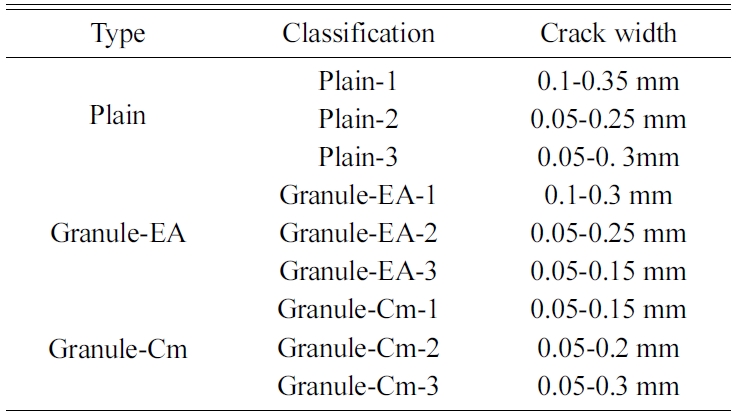
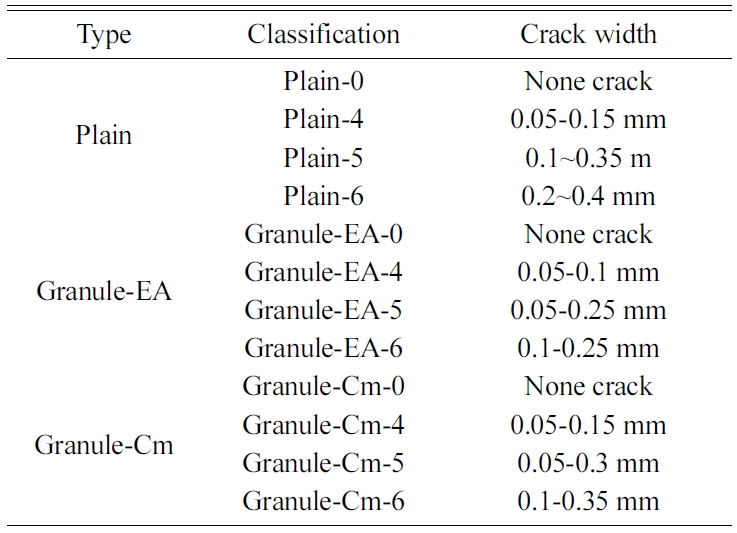
 Copyright 2019 International Orgranization for Ceramic Processing. All rights reserved.
Copyright 2019 International Orgranization for Ceramic Processing. All rights reserved.